|
|
|
Sort Order |
|
|
|
Items / Page
|
|
|
|
|
|
|
| Srl | Item |
| 1 |
ID:
117004


|
|
|
|
|
| Publication |
2012.
|
| Summary/Abstract |
This paper empirically investigates factors driving the adoption of energy-efficiency measures by small and medium-sized enterprises (SMEs). Our analyses are based on cross-sectional data from SMEs which participated in a German energy audit program between 2008 and 2010. In general, our findings appear robust to alternative model specifications and are consistent with the theoretical and still scarce empirical literature on barriers to energy-efficiency in SMEs. More specifically, high investment costs, which are captured by subjective and objective proxies, appear to impede the adoption of energy-efficiency measures, even if these measures are deemed profitable. Similarly, we find that lack of capital slows the adoption of energy-efficiency measures, primarily for larger investments. Hence, investment subsidies or soft loans (for larger investments) may help accelerating the diffusion of energy-efficiency measures in SMEs. Other barriers were not found to be statistically significant. Finally, our findings provide evidence that the quality of energy audits affects the adoption of energy-efficiency measures. Hence, effective regulation should involve quality standards for energy audits, templates for audit reports or mandatory monitoring of energy audits.
|
|
|
|
|
|
|
|
|
|
|
|
|
|
|
|
| 2 |
ID:
116997
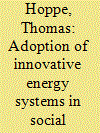

|
|
|
|
|
| Publication |
2012.
|
| Summary/Abstract |
Thanks to new insights on the impacts that dwellings have throughout their life cycles, there has been increased attention to retrofitting innovative energy systems (IES) in existing housing. This paper uses an explorative case study design to gain more knowledge about the governance aspects of this under-researched topic. The central research question is: Which factors influence the adoption of innovative energy systems in social housing sites during renovation projects? To answer this question, eight large-scale renovation projects in The Netherlands were investigated. These case studies allowed the identification of barriers, enabling factors and perspectives from three main actors-housing associations, tenants and local authorities. It turns out that adopting IES encounters many barriers: lack of trust between project partners, delay in project progress, financial feasibility considerations, lack of support from tenants, lengthy legal permit procedures, over-ambitious project goals, poor experiences in previous projects, and IES ambitions that are not taken serious by key decision-makers. Furthermore, IES were only successfully fitted in three of the eight projects. Moreover, ambitions were lowered as the projects progressed in all the cases investigated. The study calls for further systematic, in-depth comparison of fitting IES in large-scale renovation projects in social housing.
|
|
|
|
|
|
|
|
|
|
|
|
|
|
|
|
| 3 |
ID:
116985


|
|
|
|
|
| Publication |
2012.
|
| Summary/Abstract |
This paper addresses the challenge of engaging civil society stakeholders in the development process of ambitious mitigation scenarios that are based on formal energy system modeling, allowing for the explicit attachment of normative considerations to technology-focused mitigation options. It presents the definition and model results for a set of mitigation scenarios for Germany that achieve 85% CO2 emission reduction in 2050 relative to 1990. During consecutive dialogues, civil society stakeholders from the transport and electricity sector framed the definition of boundary conditions for the energy-economy model REMIND-D and evaluated the scenarios with regard to plausibility and social acceptance implications. Even though the limited scope of this research impedes inferential conclusions on the German energy transition as a whole, it demonstrates that the technological solutions to the mitigation problem proposed by the model give rise to significant societal and political implications that deem at least as challenging as the mere engineering aspects of innovative technologies. These insights underline the importance of comprehending mitigation of energy-related CO2 emissions as a socio-technical transition embedded in a political context.
|
|
|
|
|
|
|
|
|
|
|
|
|
|
|
|
| 4 |
ID:
116962


|
|
|
|
|
| Publication |
2012.
|
| Summary/Abstract |
The agriculture sector's contribution to energy production is a central issue in ongoing policy debates, and one of the central elements of the development of Bioeconomy sector. The Common Agricultural Policy (CAP) is one of the main determinants of the different farm strategies of European farmers. The CAP is now undergoing a thorough revision process which necessarily includes a debate of the role of the policy in rural areas and the effectiveness of the various CAP policy mechanisms. The objective of this paper is to assess the impact of alternative CAP scenarios in the light of the possible changes in 2013 and the willingness to adopt energy plants for energy crops in the Province of Bologna (Italy). This is pursued using both survey information and farm-household mathematical programming models, hence using stated intentions and simulated profitability to analyse the adopt of new technologies for energy production. The results underscore the relevance of the CAP scenarios in altering intentions with regard to the adoption of energy production and the relevant effect of uncertainty in delaying the diffusion of energy production systems.
|
|
|
|
|
|
|
|
|
|
|
|
|
|
|
|
| 5 |
ID:
117011


|
|
|
|
|
| Publication |
2012.
|
| Summary/Abstract |
Household food security in the United States has been extensively researched and a number of indexes have been generated. However, household energy security has been largely ignored even though low-income households spend almost equal income shares on food and energy. This paper uses Rasch models and household responses to energy security questions in the 2005 Residential Energy Consumption Survey to generate an energy insecurity index that is consistent with those found in the food insecurity literature. The analysis yields several important findings for the generation of policy relevant household energy insecurity indexes. Questions that indicate reduction of basic expenditures, such as food, clothing, and shelter, are easiest for households to affirm implying low exposure to energy insecurity. Conversely, questions that concern households leaving the residence due to extreme temperatures consistently imply high exposure to energy insecurity. Households that score in the top decile of the energy insecurity index are more likely to be headed by single-females, be younger, and have a Black household head. Rasch models also identify flaws within survey. Particularly, the scope of the questions is quite broad and a refinement of the survey questions to focus on specific attributes of energy insecurity would likely improve future energy security indexes.
|
|
|
|
|
|
|
|
|
|
|
|
|
|
|
|
| 6 |
ID:
116914


|
|
|
|
|
| Publication |
2012.
|
| Summary/Abstract |
China promulgated the Medium and Long-Term Development Plan for Renewable Energy in 2007, which included sub-targets of 2010 and 2020 for various renewable energy technologies. Almost all the 2010 sub-targets have been met and even surpassed except non-grain fuel ethanol. There is debate surrounding the questions of whether and how the country will be able to meet the 2020 biofuels target. This paper provides the assessment of potential technology pathways to achieve the 2020 target regarding their respective resource potential and supply cost. Barriers and policy options are identified based on broad literatures review. And an overview of biofuels projections is presented to provide insight into the comparison of various policy scenarios. The study shows that China can potentially satisfy non-grain fuel ethanol target by 2020 from technology perspective. But she will probably fall far short of this target if current situations continue. Additional policy efforts are needed. Meanwhile, the target of biodiesel production has high probability to be achieved. However, if given support policies, it will develop better.
|
|
|
|
|
|
|
|
|
|
|
|
|
|
|
|
| 7 |
ID:
117010
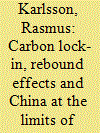

|
|
|
|
|
| Publication |
2012.
|
| Summary/Abstract |
From the beginning, the statist frame of the Kyoto Protocol has invited a focus on national carbon budgets and piecemeal mitigation within rich countries. Despite the Clean Development Mechanism and other efforts to diffuse low carbon technologies to developing countries, China has over the last decades continued to construct hundreds of new thermal coal power plants leading not only to skyrocketing emissions in the present but also to long-term carbon lock-in. In light of this, China is likely to continue to put strong upward pressure on global emissions for many decades to come. Ignoring the seriousness of this situation, many rich countries have persisted to seek marginal improvements to intermittent low-energy sources such as wind power rather than taking the lead in developing breakthrough baseload technologies such as nuclear fusion. This paper argues that only such high-energy technologies, if made significantly cheaper than any fossil alternatives, will be capable of breaking the current carbon lock-in process in China and other developing countries.
|
|
|
|
|
|
|
|
|
|
|
|
|
|
|
|
| 8 |
ID:
116989


|
|
|
|
|
| Publication |
2012.
|
| Summary/Abstract |
Russia is one of the world's major sources of carbon based energy as well as one its most intensive users. Introducing carbon taxes can lead to a reduction in emissions and encourage investment in energy efficiency. We investigate the economic effects of carbon taxes on the Russian economy under perfect competition and a Cournot oligopoly in output markets. The main findings are: (i) substituting carbon taxes for labour taxes can yield a strong double dividend in Russia; however, welfare gains strongly depend on the labour supply elasticity and elasticities of substitution between capital, labour, and energy. (ii) Under the assumption of a Cournot oligopoly with homogenous products and symmetric firms in the markets for natural gas, petroleum and chemical products, metals, and minerals, welfare costs of the environmental tax reform can be higher than under perfect competition. This is because introducing carbon taxes leads to a reduction in already sub-optimal output, thereby exacerbating pre-existing distortions arising from imperfect competition. (iii) Furthermore, increases in energy costs can result in higher mark-ups in some markets because of less competition resulting from firms' exit.
|
|
|
|
|
|
|
|
|
|
|
|
|
|
|
|
| 9 |
ID:
116922


|
|
|
|
|
| Publication |
2012.
|
| Summary/Abstract |
A CO2 emission intensity analysis in the Mexican industry from 1965 to 2010 is carried out by taking into consideration four stages: 1965-1982, 1982-1994, 1994-2003, and 2004-2010. Based on the LMDI decomposition methodology, three influencing factors are analyzed: energy intensity, CO2 coefficient, and structure in terms of their contributions of each individual attributes to the overall percent change of them as it was proposed in Choi and Ang (2011). The energy intensity effect was the driving factor behind the main decreases of CO2 intensity, the CO2 coefficient effect contributed to less extent to mitigate it, and the structure effect tended to increased it. It is observed that CO2 intensity declined by 26.2% from 1965 to 2003, but it increased by 10.1% from 2004 to 2010. In addition, the move of Mexico from an economic model based on import-substitution to an export-oriented economy brought more importance to the Mexican industry intended to export, thus maintaining high levels of activity of industries such as cement, iron and steel, chemical, and petrochemical, while industries such as automotive, and 'other' industries grown significantly not only as far their energy consumptions and related CO2 emissions but they also increased their contributions to the national economy.
|
|
|
|
|
|
|
|
|
|
|
|
|
|
|
|
| 10 |
ID:
116967


|
|
|
|
|
| Publication |
2012.
|
| Summary/Abstract |
The diffusion of cost-effective energy-efficiency measures (EEMs) in firms is often surprisingly slow. This phenomenon is usually attributed to a variety of barriers which have been the focus of numerous studies over the last two decades. However, many studies treat EEMs homogenously and assume they have few inherent differences apart from their profitability.
We argue that complementing such analyses by considering the characteristics of EEMs in a structured manner can enhance the understanding of EEM adoption. For this purpose, we suggest a classification scheme for EEMs in industry which aims to provide a better understanding of their adoption by industrial firms and to assist in selecting and designing energy-efficiency policies.
The suggested classification scheme is derived from the literature on the adoption of EEMs and the related fields including the diffusion of innovations, eco-innovations and advanced manufacturing technology. Our proposed scheme includes 12 characteristics based on the relative advantage, the technical and the information context of the EEM. Applying this classification scheme to six example EEMs demonstrates that it can help to systematically explain why certain EEMs diffuse faster than others. Furthermore, it provides a basis for identifying policies able to increase the rate of adoption.
|
|
|
|
|
|
|
|
|
|
|
|
|
|
|
|
| 11 |
ID:
116991


|
|
|
|
|
| Publication |
2012.
|
| Summary/Abstract |
Since China decontrolled coal prices, its coal price has risen steadily and been unusually volatile. In 2011 in particular, high coal prices and capped electricity prices in China discouraged coal-fired power generation, triggering widespread power shortages. We suggest that these coal-price disturbances could be symptomatic of a major change in pricing dynamics of global fossil-fuel markets, with increasing correspondence between coal and oil prices globally. Historically, global coal prices have been more stable and lower than oil and natural gas prices on a per-heat basis. In recent years, however, coal prices have been increasingly volatile worldwide and have tracked other fossil fuel prices more closely. Meanwhile, the recent development of unconventional gas has substantially decoupled US natural gas and oil prices. Technically, low US natural gas prices, with potential fuel switching, could drive US domestic coal prices lower. However, this effect is unlikely to counteract the overall trend in increasing coal consumption globally. China's market size and unique, partially-controlled energy system make its reform agenda a key force in the global economy. Policymakers in the US, E.U. and elsewhere should monitor China's economic reform agenda to anticipate and respond to changes accompanying China's increasing importance in the global energy economy.
|
|
|
|
|
|
|
|
|
|
|
|
|
|
|
|
| 12 |
ID:
116955


|
|
|
|
|
| Publication |
2012.
|
| Summary/Abstract |
China is the largest coke producer in the world, accounting for over 60% of the world coke production, which makes the coke industry in China a significant coal consumer and air pollutant emitter. Recently, China has taken a series of measures to improve energy efficiency and reduce emissions from the coke industry, including eliminating old and low energy-efficiency coking technologies, promoting advanced technologies, and strengthening energy and environmental requirements on coking processes. As a consequence, China's coke industry is experiencing an unprecedented technology shift, which was characterized by the elimination of old, inefficient, and polluting indigenous ovens and small machinery ones within 10 years. This study examines the policies and the prompt technology shift in China's coke industry, as well as the associated energy and environmental effects, and discusses the implications with respect to the development of the coke industry in China towards a more efficient and clean future. As China sets stricter requirements on energy efficiency and the ambient environment, a more significant change focusing on technologies of energy saving and emission reduction is urgently needed at present. Those mature technologies, including coke dry quenching, coke oven gas recycle, fine particle removal, etc., should be enforced in the near future.
|
|
|
|
|
|
|
|
|
|
|
|
|
|
|
|
| 13 |
ID:
116921
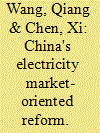

|
|
|
|
|
| Publication |
2012.
|
| Summary/Abstract |
The market-oriented reform in electricity industry has become a global trend since 1980s. Although China's electricity industry has been reformed since 1978, the substantial reform has not been conducted until 1985. Before 1985, China's power industry had been absolutely monopolized by the central state-owned companies. The absolute monopoly has been broken since 1985, when the Chinese government opened doors for non-central state-owned investment entities and foreign investors in power supplies in order to solve the chronic power shortage. In 2002, the comprehensive electricity reform plan entitled Scheme of the Reform for Power Industry was enacted. However, implementation of this plan was delayed due to electricity supply shortages. Even worse, a new kind of monopoly has been developed under the background "the state advances, the private sector retreats" in late years. In some sense, the former absolute monopoly has transformed the current relative monopoly. We contend that the relative monopoly has reversed the market-oriented reform in China's electric industry. If the relative monopoly remains unchanged, it will be harmful to public welfare.
|
|
|
|
|
|
|
|
|
|
|
|
|
|
|
|
| 14 |
ID:
116916


|
|
|
|
|
| Publication |
2012.
|
| Summary/Abstract |
Beginning in 2006, China experienced a rapid growth in its renewable energy resources, particularly wind power, placing it among the world's leading countries in terms of renewable energy installation and generation. This growth was greatly enabled by the renewable energy policy framework created by its landmark Renewable Energy Law, passed in 2005 and amended in 2009, which established key policies including: national renewable energy targets; a mandatory connection and purchase policy; a national feed-in tariff system; and arrangements for cost-sharing and funding of renewable energy incentives.
This paper describes the mechanisms established by the Renewable Energy Law and its implementing regulations, as well as the challenges China continues to face in improving its renewable energy policy framework to improve integration and utilization of renewable energy sources. It also provides a comparison of the Chinese renewable energy policy framework with those in the European Union and United States. Finally, the paper provides recommendations for improving implementation of the Renewable Energy Law, with regard to implementing a renewable power quota system and priority dispatch policy, developing technical standards for connection of renewable resources with the grid, development of a more advanced feed-in tariff system, and central-local coordination of renewable energy development.
|
|
|
|
|
|
|
|
|
|
|
|
|
|
|
|
| 15 |
ID:
116907
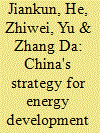

|
|
|
|
|
| Publication |
2012.
|
| Summary/Abstract |
In recent years, China has made great efforts in energy saving and carbon emission reduction by pushing forward domestic sustainable development along with global climate change mitigation. The efforts have paid off with a dramatic decrease in carbon intensity. Nevertheless, China is still confronted with tough challenges in emission control due to the fast pace of industrialization, large total historical emission and high growth rate of emissions. Therefore, China should give priority to energy saving by improving energy efficiency and sectoral structure adjustment and upgrade, and develop sustainable and renewable energy to optimize energy mix and its carbon content. China should continue to regard significant reduction of energy intensity and carbon intensity as the main objective in the near future, strive to achieve peak emissions around 2030, and realize a relatively sharp emissions reduction by 2050 in order to address climate change to meet the goal of making the warming less than 2°. During the 12th Five Year Plan (FYP), China will further strengthen measures to control the amount of energy consumption, establish a statistics, accounting and evaluation system of carbon emissions, and promote a market-based carbon emissions trading mechanism to facilitate the low-carbon transformation of China's economy.
|
|
|
|
|
|
|
|
|
|
|
|
|
|
|
|
| 16 |
ID:
116915


|
|
|
|
|
| Publication |
2012.
|
| Summary/Abstract |
Since 2005 the Chinese wind power technology industry has developed rapidly, with China becoming the largest installer of wind power capacity in the world in 2010. This paper reviews the policy system implemented in China to support the wind power industry, centered on China's 2005 Renewable Energy Law. It examines the industry's achievements over the past two decades, including the development of wind power technology and equipment, the utilization of China's wind power resources, and the cost reductions achieved. It then explores the obstacles affecting the ongoing sustainability of the Chinese wind industry, including regulatory barriers, grid integration challenges, and challenges to continued technological innovation. It recommends that integration challenges be addressed through policy reforms, establishing interconnection standards, and creating predictability with forecasting and storage; that market signals be established with long-term development goals and pricing reforms; and that industry limitations be addressed with targeted R&D, improved wind resource assessment and transparency, domestic and international collaborations, and the cultivation of a skilled workforce.
|
|
|
|
|
|
|
|
|
|
|
|
|
|
|
|
| 17 |
ID:
116975


|
|
|
|
|
| Publication |
2012.
|
| Summary/Abstract |
Information on energy consumption and carbon dioxide (CO2) emissions from the iron and steel industry may become important to the assessment of energy saving and the design of emissions trading schemes. This paper focuses monitoring aspects, used two methods to calculate CO2 emission, the European Union Emission Trading Scheme and a method developed by the Japanese Iron and Steel Federation, to investigate the effect of the accounting method on the assessment of energy saving by four model steel mills with different levels of energy efficiency. Depending on the calculation method used, the calculated energy savings and calculated CO2 emissions for a given mill were found to differ from 5% to 15% and 4% to 14% respectively, simply by using different calculation methods. Methodologies that evaluate only CO2 emission and track emissions by process may not fully account for energy saving efforts such as using waste heat, generating power using byproduct gases, and energy management efforts applied over the whole mill rather than on a single process. Points of concern in the iron and steel industry are identified in the areas of calculating energy saving, determining CO2 emissions, and setting benchmarks.
|
|
|
|
|
|
|
|
|
|
|
|
|
|
|
|
| 18 |
ID:
116951
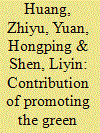

|
|
|
|
|
| Publication |
2012.
|
| Summary/Abstract |
Green residence development has been one of the important strategies for promoting sustainable urban development. Governments throughout the world have been encouraging property developers to deliver green properties. In line with this development, governments have been implementing various assessment programs to certify green residential buildings with the aim of contributing to sustainable urban development. With reference to the Chinese construction practice, this paper examines the effectiveness of the green residence assessment scheme toward its defined aim through investigating the contents and procedures of the green residence assessment scheme by referring to the practices of Chongqing city in western China. Based on the results of five case studies and five semi-structured interviews, this study reveals the significant contribution from implementing the green residence assessment scheme particularly to energy saving in residential buildings. Further, the green residence assessment scheme promotes the application of green building materials and green construction technologies in the entire process of delivering and operating residential buildings. The findings provide valuable references for further investigating alternative methods to achieve better energy saving in developing residential buildings.
|
|
|
|
|
|
|
|
|
|
|
|
|
|
|
|
| 19 |
ID:
116937


|
|
|
|
|
| Publication |
2012.
|
| Summary/Abstract |
We develop a metric to quantify the sub-hourly variability cost of individual wind plants and show its use in valuing reductions in wind power variability. Our method partitions wind energy into hourly and sub-hourly components and uses corresponding market prices to determine variability costs. We use publically available 15-min ERCOT data, although the method developed can be applied to higher time resolution data if available. We do not estimate uncertainty costs though our metric can separate integration costs into variability and uncertainty components. The mean variability costs arising from 15-min to 1-h variations (termed load following) for 20 ERCOT wind plants was $8.73±$1.26 per MWh in 2008 and $3.90±$0.52 per MWh in 2009. Load following variability costs decrease as capacity factors increase, indicating wind plants sited in locations with good wind resources cost a system less to integrate. Twenty interconnected wind plants had a variability cost of $4.35 per MWh in 2008. The marginal benefit of interconnecting another wind plant diminishes rapidly: it is less than $3.43 per MWh for systems with 2 wind plants already interconnected, less than $0.7 per MWh for 4-7 wind plants, and less than $0.2 per MWh for 8 or more wind plants.
|
|
|
|
|
|
|
|
|
|
|
|
|
|
|
|
| 20 |
ID:
116982


|
|
|
|
|
| Publication |
2012.
|
| Summary/Abstract |
We study the costs of electricity disruptions in Cyprus, which suffered severe power shortages in summer 2011 after an explosion that destroyed 60% of its power generating capacity. We employ both economic and engineering approaches to assess these costs. Among other calculations, we provide estimates of the value of lost load by economic sector and the hourly value of electricity by season and type of day. The results of two economic methods employed to assess welfare losses differ largely, indicating that the assessment of outage costs is associated with many uncertainties. Our calculations show that the emergency actions taken by national energy authorities in response to that accident, though not necessarily optimal, have generally been appropriate and in line with international best practices: the additional costs incurred due to these measures are lower than the economic losses avoided thanks to these actions. Preferential treatment of specific consumer types in the case of repeated power outages remains an open policy question.
|
|
|
|
|
|
|
|
|
|
|
|
|
|
|
|
|
|
|
|
|